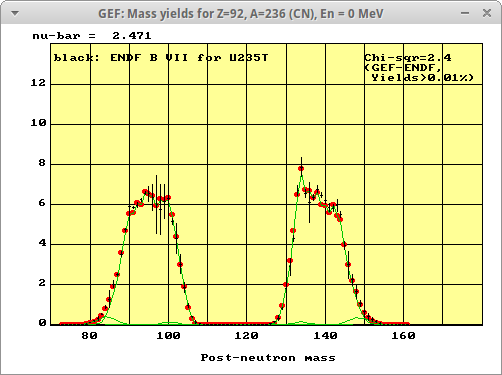GEF 2017/1.1
General
description of fission observables. Released September 24, 2017.
Short characterization: GEF 2017/1.1 is the result of an effort the better reproduce the mass distribution of 235U(nth,f).
The concentration on this system deteriorated the agreement with other
data. A new global re-adjustment of the model parameters is in progress.
Properties of GEF 2017/1.1: GEF
2017/1.1 is the result of a new (preliminary) fit of the model parameters to
experimental data. In particular, the mass distribution of 235U(nth,f),
the system for which the most accurate data exist, was considered with
special care. The description of these data could appreciably be
improved by discarding the yield of A=129 from ENDF/B-VII. After
careful
studies, we came to the conclusion that this value is not correct and
that it considerably disturbed previous fits. Moreover, in contrast to
previous GEF versions that used theoretical masses, GEF
2017/1.1 uses experimental masses and appropriately chosen level
densities in the evaporation routine in order to better model the fine
structure in the fission-fragment yields. By these measures, the
reduced Chi-squared for the mass distribution of 235U(nth,f) decreased
from 7.6 in 2016 to 2.4 (see figure below).
Moreover, a few
inconsistencies in the description of the fluctuations in the division
between TKE and TXE were corrected.
GEF
2017/1.1 should be considered as preliminary, because a comprehensive
fit of the model parameters regarding all fission quantities over a
large range of fissioning systems has not yet been made.
The mass distribution of 235U(nth,f) from GEF-2017/1.1 (red
points) in
comparison with the ENDF/B-VII evalution (black symbols with error
bars). Note the appreciably reduced value of Chi-squared compared to
previous GEF versions. The calculated contributions from different
fission channels are traced in green. 10 million events have been
calculated. The data point for A=129 is taken from H. Thierens, D. de
Frenne, E. Jacobs, A. de Clercq, P. D'Hondt, A.J. Deruytter
, Nucl.
Instrum. 134 (1976) 299-308.
An extended version of GEF-2017/1.1
that
includes delayed processes (output of delayed-neutron multiplicities,
delayed-neutron emitters, cumulative fission-fragment yields in ENDF
format) is available on demand. It provides also an
option for producing random files of fission-fragment yields in ENDF
format.
We
are happy about any feed-back (mail to
schmidt-erzhausen<at>t_online.de). This helps to correct errors,
to improve the quality of the model and to better respond to the needs
and preferences of the users.
Use of the GEF code is subject to the GNU GENERAL PUBLIC LICENSE
agreement that you find here: <License>.
Stand-alone version (Monte-Carlo method)
The
stand-alone version of the GEF code is written in FreeBASIC (a). The
FreeBASIC compiler produces binary code from the same source on Windows
(b) and on Linux. The executable uses the C library. For
the Windows
version, a GUI is provided, written in JustBasic (c). The Windows
version runs also on Linux with Wine (d). The Windows version runs also on OS X (e)
with Wine (d).
a) FreeBASIC is available from http://www.freebasic.net/ with no
cost.
b) Windows is either a registered trademark or a trademark of Microsoft
Corporation in the United States and/or other countries.
c) JustBasic is available from http://www.justbasic.com/ with no cost.
d) Wine is a windows compatibility layer for Linux and Mac OS X
(http://www.winehq.org/).
e) OS X is a trademark of Apple Inc., registered in the U.S. and other
countries.
Quick start on Windows:
- Download the binaries
(that includes some additional files).
- Start GEF.bat in a
command window.
- Fill in the input mask of the graphical user interface and start
the calculation.
- Output is written to file \out\...
.dat.
Quick start on Linux:
- Download the binaries.
- Make sure that the binary file GEF is executable.
- Enter ./GEF in a command
window.
- Answer the input dialogue.
- Output is written to file
/out/... .dat.
Windows version
Input mask of the graphical
user interface:
For Windows and Linux
Complete
package
Documentation
Readme file
(Technical information, list of relevant publications)
JEFF-Report
24, part I
(Comprehensive documentation of the GEF model.)
JEFF-Report
24, part II
(Technical information on the GEF code.)
Source (for Windows and Linux)
Source
files
Data
Input files for extended input options
Distribution of entrance energies (example)
List of input parameters (example)
See Readme file
for more detailed information.
Output
Data tables in XML format (example)
List-mode file (example)
(short sample of most complete event list)
Raw data for the multi-variate distribution of fission-fragment yields
from calculations with perturbed parameters (example)
See Readme file
for more detailed information.
You
may consider using the Windows version of GEF on Linux with Wine in
order to profit from the more comfortable input handling offered by the
graphical user interface. This option may also solve problems of
missing libraries under Linux.
Subroutine (Folding method)
The subroutine aims for being used
in combination with other nuclear-reaction codes. For a given
fissioning nucleus with excitation energy E* and angular momentum I
it calculates complete distributions of a number of fission observables
before emission of prompt neutrons and prompt gamma radiation with the
GEF model.
Documentation
Technical description of the subroutine
FreeBASIC version
In preparation
FORTRAN version
In preparation


